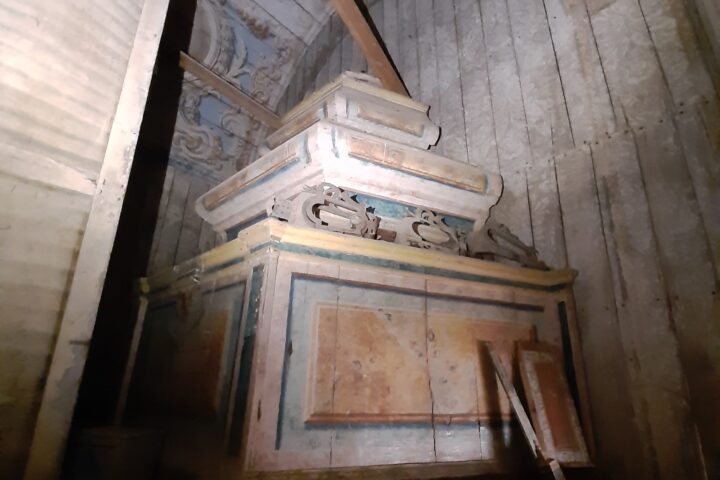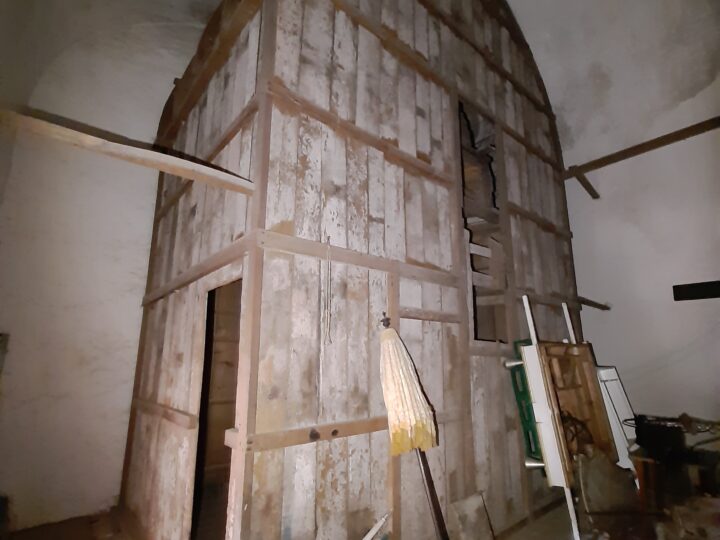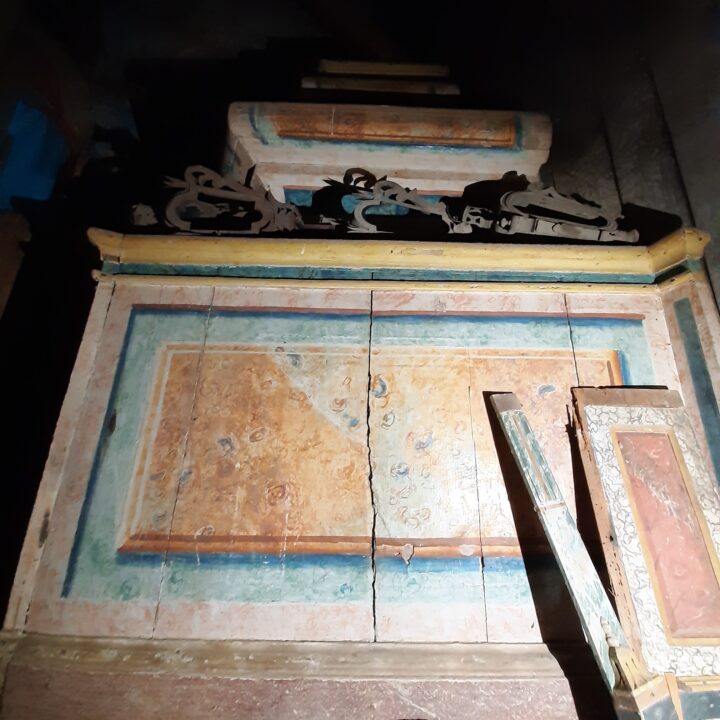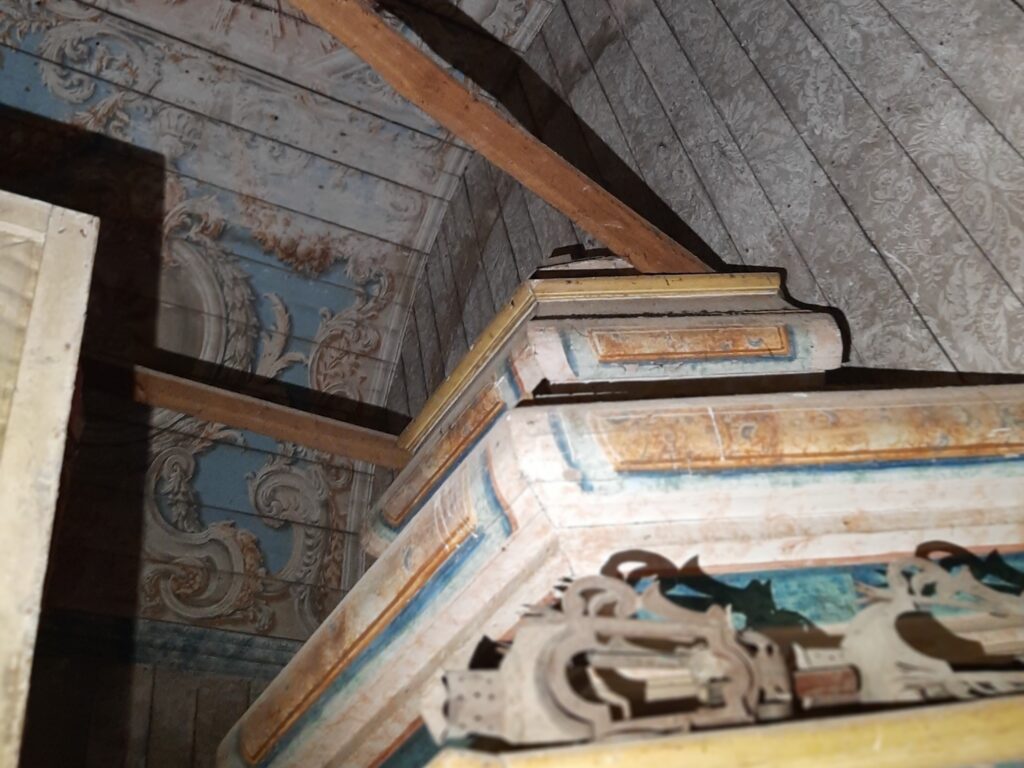A large plinth made up of several superimposed steps and walls covered with decorative paint were found, at the end of October, in the chancel of the Igreja Matriz in Santa Maria do Castelo, in Tavira.
The elements that are hidden, according to Daniel Santana, art historian, currently linked to the Municipal Museum of Faro, were an integral part of the current main altarpiece, which «was thus originally endowed with a tribune, that is, a relatively deep space existing in the central part of some altarpieces and a stepped pyramidal throne».
On the walls there are paintings on wood with architectural and plant motifs involving "a card at the top with the name of God (Jehovah) in Hebrew characters and another two on the sides with Eucharistic symbols, such as wheat and grapes."
Also according to Daniel Santana, the main altarpiece, dating from the end of the XNUMXth century or beginning of the XNUMXth century, «was initially thought of as a Eucharistic altarpiece, a typology where the elements we find here, linked to the worship of the Blessed Sacrament, are common.
“This is one of the few fake altarpieces in Tavira, painted in “trompe l'oeil”, says the historian.
It is attributed to the Loulé painter Joaquim José Rasquinho, an artist esteemed by the then Bishop of the Algarve, D. Francisco Gomes do Avelar, promoter of the reconstruction of this church in the late XNUMXth century”.

What, then, justified the alteration of the altarpiece and the concealment of these elements? Daniel Santana explains: «We don't know for sure, but the lack of finishing of the paintings in some areas indicates that there was a change in the original idea during the design of the altarpiece. We assume that it may have been the arrival of the image of Our Lady of the Assumption, which today occupies a prominent place in the center of the altarpiece, that determined the alterations made.
It is a sculpture of excellent technical execution, attributable to the circles in the workshop of the famous sculptor Machado de Castro, which placed it on a level of excellence in terms of the commission and the place the temple should occupy. This may have justified the replacement of the altarpiece typology, converting it into a devotional altarpiece with greater focus on the image of the patroness.
The tribune space was then closed by a scenic wooden panel, with fake curtains that solemnly frame the machine that houses the image of Our Lady».
«It should also be noted that the Eucharistic altarpiece located in the Chapel of the Blessed Sacrament dates from this period in the early XNUMXth century, which is also related to the abandonment of the original idea of the main altarpiece, justifying the return of the tabernacle and the cult of the Blessed Sacrament Eucharist for the side chapel, a situation that would have occurred before the earthquake», he concludes.
To get a closer idea of how the main altarpiece of Santa Maria would be presented according to its initial version, «just look at the Eucharistic altarpiece of the Church of Espírito Santo do Hospital, in Tavira, a coeval work by the same Joaquim Rasquinho , dated 1805. For this reason, it holds great affinities with its counterpart in Santa Maria», says the researcher.
Also according to Daniel Santana, “the religious heritage of Tavira has provided us with some surprising revelations in recent years, whenever conservation interventions are being prepared or processed. For example, in the restoration work on the hermitage of S. Sebastião, in 2008, a fake altarpiece from the mid-XNUMXth century was revealed, painted and hidden behind the wooden altarpiece. Years later, during the restoration of the Church of Nossa Senhora das Ondas, several vestiges of ancient mural paintings were also discovered, representing “temporary” altarpieces that would have served the cult while the wooden altarpieces were awaited».

Regarding the state of these findings, «the polychrome throne with marble tiles is in good condition, with only occasional gaps in terms of polychrome. The walls, composed of wooden boards and covered with decorative paint, show great wear caused by the humidity of the place and the consequent lack of adherence to the support.
In the outer area, the thin back of the wood is quite degraded in some areas, with signs of attack by wood-cutting insects and weakened by high levels of humidity. All over the structure, oxidized metallic elements and a large accumulation of organic dirt are visible», observes Marta Pereira, Conservator-Restoration at Artgilão.
This curious heritage “discovery” took place on the eve of the start of conservation and restoration work in this church. It was considered an ideal time for those responsible for the Parish to promote the inspection and tidying up of the various divisions of the temple.
Therefore, when going through one of the doors, which are almost always closed to the main altarpiece, and going up a small staircase, they came across a dark and cramped wooden compartment at the back of the altar, where they were surprised by the presence of some ancient remains.
"An ARTGilão official came to meet me and asked me to go to the Church of Santa Maria, to let me know of a finding", says Daniel Santana, testifying to the satisfaction he found upon arriving at the place: "I was pleasantly surprised" , remember.

Regarding the conservation and restoration work, scheduled to start shortly, Marta Pereira emphasizes that «the priority will be to stabilize the materials in order to halt the process of degradation and prolong the life of a space that wants to be preserved, such as historical document that it is».
It will also be analyzed the need and feasibility "of a restoration with a view to integrating the missing polychrome areas, which is not an urgent action, it promotes a more fluid reading of the whole", says Marta Pereira.
Miguel Neto, the parish priest of Tavira, expresses his joy at having managed to understand the functionality of these findings and says: «it is important to preserve, to do what, in technical terms, is the most correct, so that in the future this may be a more witness. of the rich and vast history that Tavira has in relation to Sacred Art».
And he emphasizes: «understanding the importance of preserving and dignifying was, precisely, the motto for the creation of ARTgilão TAVIRA and for having, with us, Marta and Inês, who can immediately act to preserve the findings that now or in the future may come to be found.'



















Comments